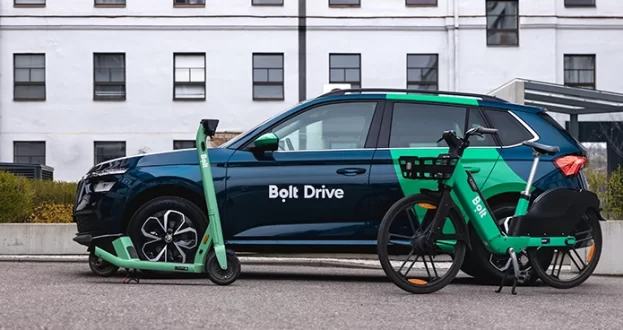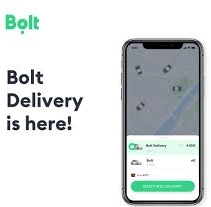Developing a successful presence on Bolt involves a multifaceted approach that combines understanding the platform’s unique features with strategic engagement. In this article, we will explore What is Bolt, how does Bolt work, and the key features that can enhance your experience as both a rider and a driver. By diving into these areas, you’ll gain valuable insights on how to optimize your use of Bolt, whether you’re looking to offer transportation services or make the most of this dynamic mobility platform in today’s competitive market.
Bolt: The Beginning
Initially known as Taxify, Markus launched Bolt in 2013 when he was just 19 years old. Starting with a modest €5,000 loan from his parents, Markus, along with his parents and a developer, launched the business under the name mTakso in August 2013. The company quickly made strides, expanding beyond its initial market and reaching international shores within a year.
What is Bolt?
Bolt is a leading transportation platform that provides ride-hailing, electric scooter rentals, and food delivery services. Founded in 2013 by Markus Villig, the company aims to offer affordable, reliable, and eco-friendly transportation solutions. Initially launched as a ride-hailing app, Bolt has since expanded into various mobility services, including electric scooter rentals and delivery options in cities worldwide.
Bolt distinguishes itself with its focus on sustainability and lower commission rates for drivers, making it an appealing option for both riders and service providers. Available on both iOS and Android, Bolt connects users with local drivers or electric scooters for quick, affordable rides.
Aspects of Understanding Bolt:
- Ride-Hailing: Bolt allows users to book rides through its app, offering services such as standard rides, electric cars, and even eco-friendly transportation options.
- Electric Scooters: Bolt also provides dockless electric scooters for short-distance travel, supporting sustainable transport initiatives.
- Bolt Drive: A car rental service where users can rent vehicles via the Bolt app without the need for a traditional rental service.
- Safety Features: Bolt emphasizes safety for both drivers and riders, implementing real-time ride tracking, emergency assistance, and a rating system to ensure quality and security.
- Environmental Focus: Bolt’s “Green Plan” aims to reduce its carbon footprint, with initiatives like offering more eco-friendly vehicles and reducing emissions in the transportation industry.
Key Features of Bolt
- Ride-Tracking, In-App Payment, and Rating Systems: Bolt offers real-time ride tracking, seamless payment options, and a reliable rating system for both riders and drivers.
- Eco-Friendly Services: With electric scooters and cars, Bolt emphasizes sustainable transportation and reducing carbon emissions.
- Safety Focus: Bolt prioritizes safety, implementing features like driver background checks, 24/7 support, and emergency assistance.
Bolt offers a variety of services designed to cater to different transportation needs. Here are the main services provided:
- Ride-Hailing: Bolt’s core service allows users to request rides from nearby drivers via the app. It includes various vehicle options, from standard cars to premium options.
- Electric Scooters: Bolt provides dockless electric scooters for short-distance travel, promoting eco-friendly transportation.
- Bolt Food: This service enables users to order food from local restaurants for delivery through the Bolt app.

- Bolt Drive: A car rental service offering short-term rentals of vehicles for self-driving, giving users flexibility and convenience.

- Airport Shuttle Service: Bolt offers dedicated transportation between airports and various destinations, with fixed pricing and easy booking through the app.
- Parcel Delivery: Bolt provides delivery services for small parcels, allowing users to send packages quickly within the city.
How Does Bolt Work?
Bolt operates as a user-friendly app that connects riders with drivers for transportation or provides access to electric scooters for short trips. Here’s how it works for both riders and drivers:
For Riders:
- Download and Sign Up: Users download the Bolt app on iOS or Android and create an account.
- Request a Ride: Enter your destination, and the app shows available drivers nearby. You can also see an estimated fare before confirming the ride.
- Track Your Ride: Once a driver accepts the request, users can track their ride in real time through the app.
- Payment: Payment can be made via cash, credit card, or an in-app payment system after the ride is completed.
Explore more about payment solutions by checking out our article: How does Square work?
- Rate the Experience: After the trip, users can rate the driver and leave feedback.
For Drivers:
- Sign Up as a Driver: Drivers register with Bolt, providing necessary documents such as driver’s license, vehicle details, and background checks.
- Receive Ride Requests: Drivers receive trip requests via the app and can accept or decline based on their availability.
- Navigate the Route: The app provides navigation to the passenger’s location and destination.
- Get Paid: After completing the ride, the fare is transferred to the driver’s account, with Bolt taking a lower commission compared to competitors.
Bolt Business Delivery

This service allows vendors to deliver their products to their customers affordably using an easy-to-use web interface. Bolt Business Delivery offers the following services
- API
- On-demand or scheduled deliveries from vendors to customers
- Multiple drops off to multiple customers in a single run
How Does Bolt Work Abroad?
For readers curious about how Bolt works abroad, here’s a glimpse into its international model. Since its early days, Bolt has successfully expanded into foreign markets by adapting to local needs while following key strategies that made it thrive.
In 2018, Bolt launched its electric scooter service in Europe under the new Bolt brand. After an initial setback, Bolt re-launched in London in 2019 with 20,000 registered drivers. That same year, Bolt introduced its food delivery service, Bolt Food, alongside its “Green Plan” to reduce carbon emissions. This plan aims to cut Bolt’s CO2 emissions by 5 million tonnes by 2025 and offer eco-friendly ride options. These efforts helped Bolt rank third in the FT 1000: Europe’s Fastest-Growing Companies.
How does Bolt Business Delivery work?
Businesses can take advantage of this service using an easy-to-use web interface. Here is a glimpse of its web interface:
- Businesses can either upload their CSV or enter the details manually by filling out the form.
- Pick-up orders can be set to be picked up immediately or can be scheduled to be collected within 48 hours.
- The user will get an estimated amount as per the order system
- Once the details are filled in and the price is confirmed, the company will dispatch a courier to collect the order at the specified time
- The courier will then be delivered to the specified location at the specified time.
If the business user is willing to make batch deliveries then that option is also available at the Bolt web interface. Bolt couriers will manage multiple drop-offs to several customers in a single run. In addition to this, a real-time tracking feature is also available on the web interface that ensures that both vendors and customers can stay updated on the progress of the order.
Business users receive a live status update on their web app and the end-customer gets an SMS letting them know that their delivery is on the way. The SMS received by the end customer will also contain the estimated time of arrival (ETA) with the Bolt courier’s contact details.
How Bolt App can be used?
Here’s a step-by-step guide on how to use Bolt:
- Download the App: Install the Bolt app from the Google Play Store or Apple App Store.
- Create an Account: Open the app and sign up by entering your phone number, email, and setting a password. Follow the verification process to complete your registration.
- Set Up Payment: Add your payment method in the app. Bolt accepts credit/debit cards and, in some regions, cash.
- Book a Ride:
- Open the app and enter your destination.
- Choose your ride type (e.g., Standard, XL, Electric Scooter).
- Confirm your pickup location and select a driver from the available options.
- Track Your Ride: Monitor the driver’s progress in real time on the map. You’ll receive notifications about the driver’s arrival.
- Enjoy Your Ride: Once your driver arrives, get in the car and enjoy the ride. The app will provide details about the route and estimated time of arrival.
- Make Payment: After reaching your destination, the payment will be processed automatically through the app. You can also pay with cash if preferred.
- Rate Your Experience: After the ride, you can rate the driver and provide feedback about your experience. This helps maintain the quality of service on the platform.
Key Phases of Launching Bolt:
- Initial Launch:
Bolt was founded in 2013 in Estonia, initially focusing on ride-hailing services. With a small team and limited funding, Bolt started by providing an alternative to traditional taxi services, focusing on affordability and better driver conditions. - Global Expansion:
After its successful debut, Bolt quickly expanded its services to other countries, starting in Europe and gradually moving to Africa, Asia, and beyond. Bolt’s flexibility in adapting its services to local markets and regulatory environments helped accelerate its global reach. - New Services:
Bolt diversified its offerings beyond ride-hailing. The company launched, a food delivery service, and Bolt Drive, a car-sharing service. Additionally, Bolt introduced e-scooter rentals as part of its mission to promote eco-friendly transportation solutions. - Focus on Sustainability:
Bolt emphasized green initiatives through its Green Plan, which aims to reduce the company’s carbon footprint by promoting electric scooters, electric vehicles, and other environmentally friendly transportation options. - Technology and Safety:
Bolt’s app, featuring ride-tracking, in-app payments, and real-time safety features, contributed to its success by offering convenience and security for users. Both riders and drivers are required to adhere to safety protocols, enhancing the platform’s trustworthiness.
Comparison with Competitors
| Feature | Bolt | Uber | Lyft |
|---|---|---|---|
| Global Reach | Operates in over 45 countries, mainly in Europe and Africa. | Present in 70+ countries worldwide. | Primarily operates in the U.S. and Canada. |
| Commission Rates | Lower commission rates for drivers (typically 10-20%). | Higher commission rates (up to 25%). | Similar commission structure to Uber. |
| Sustainability Initiatives | Strong emphasis on eco-friendly transport (e-scooters, electric vehicles, “Green Plan” initiative). | Generally, prices are higher, particularly in North America. | Growing focus on carbon neutrality and green initiatives. |
| Driver Focus | Focuses on driver welfare with low commissions and flexible payment options. | Similar driver support, but with higher commissions. | Also driver-friendly but commissions can vary. |
| Service Diversity | Recently investing in sustainability is not as central as Bolt’s Green Plan. | Primarily focused on ride-hailing and food delivery (Uber Eats). | Ride-hailing and, in some locations, food delivery (Lyft Delivery). |
| Safety Features | Standard safety measures like ride tracking and emergency assistance. | Offers similar safety features, plus real-time ID checks for drivers. | Comparable safety features with options for additional in-app safety measures. |
| Pricing | Often more affordable in regions it operates in, especially in Europe and Africa. | Generally higher prices, particularly in North America. | Pricing is regionally competitive but usually higher than Bolt. |
| App User Experience | Simple, easy-to-use interface with real-time ride tracking. | Sophisticated app with multiple features but can be cluttered. | Clean and user-friendly interface with similar features to Uber. |
To understand how ride-hailing platforms like Uber and Lyft operate, check out our article on
Uber: how does Uber work?
Lyft: How does Lyft work?
Sustainability and Innovation

- Bolt’s Green Initiatives: Bolt is committed to reducing its environmental impact through various green initiatives. This includes the introduction of electric vehicles and scooters, which align with its “Green Plan” aimed at reducing carbon emissions in the transportation sector. Bolt plans to offset at least 5 million tonnes of CO2 by 2024 and continues to expand its fleet of eco-friendly transport options.
- Technological Advancements: Bolt leverages cutting-edge technology to enhance its services. This includes advancements in its app for improved user experience, such as real-time tracking, seamless payment options, and enhanced safety features. Bolt also invests in smart algorithms to optimize ride matching and operational efficiency.
User Experience and Safety Measures
- Safety Features: Bolt prioritizes the safety of both riders and drivers. Key features include an in-app emergency button, real-time ride tracking, and comprehensive driver background checks. These measures are designed to provide peace of mind and ensure secure rides for all users.
- Customer Service and Support: Bolt offers robust customer support to address any issues or concerns. Users can contact support through the app or website for assistance with bookings, payments, or any other service-related queries. The platform also provides resources for resolving disputes and ensuring a positive user experience.
Future of Bolt
- Upcoming Features or Services: Bolt is continuously innovating to stay ahead in the competitive mobility market. Upcoming features may include expanded green transport options, enhanced app functionalities, and new service offerings such as additional delivery options or integrated transportation solutions.
- Trends in Mobility: Bolt is adapting to trends such as increased demand for sustainable transport solutions and the rise of smart cities. The company is investing in technology and partnerships that align with these trends, ensuring it remains relevant and responsive to changing market needs.
Discover how the marketplace model contributes to innovation and growth in various sectors in our detailed article.
TL;DR: What is Bolt? and how does Bolt work?
Bolt is a ride-hailing and transportation platform originally known as Taxify, founded in 2013. It connects users with drivers for various transportation services, including rides, electric scooters, and car rentals. The app allows users to book rides, pay through the app, and track their journeys in real-time. Bolt also emphasizes eco-friendly options and has introduced features like a “Green Plan” to reduce carbon emissions. To use Bolt, users need to create an account, book services via the app, and complete transactions electronically.
How do you launch your own business Similar to Bolt?
If you’re looking to launch your own platform similar to Bolt, which offers vehicle hire and food delivery services, consider using a Bolt Clone. This solution comes with customized features tailored to help you start and manage your own business efficiently. Whether you want to focus on vehicle hire, food delivery, or both, a Bolt Clone provides a robust foundation to get your platform up and running smoothly.

